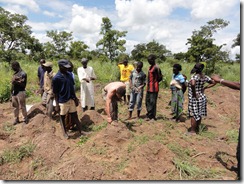On Thursday of last week, a couple of people from the MoFA research unit were in town to review test plots for the Root & Tuber Program (around here tuber generally means yams and roots generally means cassava – the two biggest crops in the Kpandai district). I accompanied them to the field along with one of the Agriculture Extension Agents (AEAs) from my office.
The idea of the program is to plant roughly 1 acre test plots where 1/3 is planted by the locals as per their normal practices, 1/3 is planted using MoFA best practices, and 1/3 is for experimenting with new ideas. The two goals are to help locals adopt best practices and to innovate new ideas based on local knowledge.
The two plots were located in villages close to Ekumidi, a town about 40km away from Kpandai on bumpy dirt roads. The arrival of outsiders in towns like this is a bit of an event, especially when there’s an Obruni (white guy), so it’s not too hard to get the farmer groups who are responsible for the test plots out for a meeting to discuss progress.
After the meeting, we went to the nearby field that had been originally prepared for yams, but they didn’t plant in time and so the decision was made to switch to cassava. Both are planted in mounds of earth spaced roughly 1.2 meters apart.
The Root & Tuber Program representatives had brought cassava cuttings for planting, but they said that the men in the village must weed the plot before they would let them plant.
After watching the village men weed for a couple of minutes, I picked up a spare hoe and decided to give it a whirl. This attracted a lot of attention an laughter. The chief of the village wound-up giving me personal instruction and the men and boys of the village delighted in finishing their rows way before me and then standing at the end of the field and watching me catch up.
I think I gained a bit of respect by refusing to quit until all the work was done despite having quickly developed a couple of large blisters on my soft office hands and the fact that I was dripping sweat while it seemed almost effortless for the other guys. All in all, I worked on the field for only a couple of hours, but I have to admit that I was hurting a bit the next day. Although my personal physical contribution probably wasn’t that great, I think I helped manage to turn a chore into a bit of fun and I also gained a bit more appreciation for what hard work farming is.
I also think that my two hours of manual labour helped to build some trust and respect with the AEA from my office and the Root & Tuber Program representatives. We had a great chat in the truck on the way home about how important having strong farmer groups is to the success of most of MoFAs programs and how Engineer’s Without Borders’ Agriculture As A Business (AAB) curriculum could help. 🙂





Hope you were wearing sunscreen. 🙂
Great comment @Colette. Hahaha.
Seriously though, pursuing creative methods of developing trust seems super important to be able to collaborate effectively during your short time there. Do you think there will be more opportunities to participate in some of the physical components of the field work? Or, what other actions are you thinking of to build trust?
Mark, your’e helping teach and support the farmers, and also working hands on, thought you might be interested in the final step with food ~ cooking.
Recipe rescue for rice, yams, cassava, ground nut stew and even peanut brittle ~ the secret is in the spices!
Don’t know how much cooking you are doing, but I hope you find some to try and enjoy. Should find everything you need at the market.
http://www.foodbycountry.com/Germany-to-Japan/Ghana.html